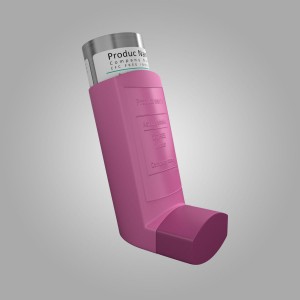Asthma has characteristic clinical syndromes: coughing and broncho-obstructive. Disease affects both children and adults. The most characteristic disease’s symptom is asthma attack. Asthma attack is a sudden emergence of lack of air sense, and is accompanied by wheezing.
The Main Disease Symptoms
The main asthma symptoms are:
- paroxysmal dyspnea;
- wheezing occurrence;
- heaviness and congestion in chest;
- dry paroxysmal cough.
Asthma symptoms are manifested mainly at night or in the early predawn hours. This fact is associated with reduction in anti-human hormones level during night (according to the natural daily rhythm).
Asthma attacks, characteristic of asthma, may be terminated either spontaneously or under the influence of drugs that enhance bronchial capacity. This feature of reverse attack distinguishes asthma from chronic obstructive pulmonary disease (COPD), cause of which is tobacco and tobacco products smoking.
Asthma attacks begins when exposed to irritating environmental factors, which are called triggers.
Such provoking factors that cause asthma attack symptoms are the following:
- Inhalation of cold air;
- The sharp irritating odor;
- Contact with allergens (pollen, allergens animals);
- Tobacco and tobacco products smoking, including passive smoking (inhalation of tobacco smoke of other smokers);
- Forcing of physical activity (brisk walking, running);
- Admission of aspirin-containing drugs or their analogues.
Scientists, researchers and doctors identify several types of asthma, depending on factors causing it:
- Allergic asthma;
- Cold asthma;
- Aspirin – induced asthma;
- Infectious-dependent asthma;
- Exercise-induced asthma;
- Cough -variant asthma;
- Bronchial asthma with COPD.
Breathlessness attacks in asthma may be associated with dry cough. After this attack viscous sputum in small quantities is discharged. Sputum is usually glassy and may be colored in amber color. In case of allergic form of disease sputum has purulent character.
Sometimes classic choking replace other symptoms:
- persistent cough, often dry or unproductive;
- sputum discharges with difficulty, after prolonged coughing it has viscous glassy consistency.
In this case, after further studies confirming asthma symptoms, diagnosis of cough-variant asthma is established.
What Factors Lead to Disease?
The exact causes of asthma can not be defined by scientists and researchers. In medical science, there is notion of predisposing factors. At the moment scientists identified factors external and internal environment affecting disease’s development and manifestation.
Internal Factors that Contribute to Disease Manifestation
Internal genetic factor leading to development of allergic disease’s form, scientists believe, is genetic predisposition. Observations show that allergic asthma probability is much higher in families where close relatives have suffered any allergic disease.
Also genetic factors that contribute to disease’s manifestation are obesity and gender. Bronchial asthma is more common in people among adults who are overweight.
Belonging to male sex the risk of asthma in early childhood increases. At boys under age of 14 years incidence of asthma is twice higher than that of girls in the same age group.
In adults, situation with asthma incidence is opposite. Among adults, disease’s prevalence among women exceeds that of men.
External Factors of Disease Development
External factors that cause asthma development, are often triggers that provoke appearance of breathlessness attacks.
List of such external factors is quite extensive:
- Allergens can trigger exacerbations of allergic disease’s form.
- Some respiratory viruses may contribute to appearance of bronchial asthma in children and adults (respiratory syncytial virus, parainfluenza virus).
- Professional stimuli (isocyanates, platinum salts, substances of plant and animal origin).
- Smoking – mothers, including during pregnancy. This fact greatly increases risk of asthma in child. Systematic contact with tobacco smoke (passive smoking) also increases risk of asthma in adults.
- Air pollution from smoke and fumes from burning gas and other fossil fuels, as well as mold spores and cockroach products contribute to asthma exacerbation.
- If you baby is on artificial feeding from soy protein or cow’s milk, symptoms of asthma in early childhood appear more likely than in children in natural breastfeeding.
Smoking is not proven to cause asthma. But it is known that tobacco smoke greatly complicates its treatment and prevents disease control achievement. Exacerbations and hospitalizations are significantly higher frequency at smokers, decreased lung efficiency is faster, which increases risk of death. Treatment of antiasthmatic medications is ineffective in smokers. But if you really want to get rid of asthma you should quit smoking and command the service of Canadian Family Pharmacy online to order medications to eliminate asthma symptoms.
How Does Doctor Establish Asthma Diagnosis?
Asthma diagnosis begins with assessment of patient’s typical complaints, determining outward signs and predisposing factors. If a person has symptoms such as paroxysmal dyspnea, wheezing, feeling of chest heaviness, asthma attack in past, diagnosis of asthma is very likely.
Clinical syndromes characteristic of asthma, are indication for further patient’s examination. To determine degree of lung abnormality, severity of spasm in airways and bronchial reaction to medication, patient is prescribed pulmonary function tests (PFT).
During PFT doctor may determine increased bronchial sensitivity to stimuli. Signs of excessive airway sensitivity to external influence are significant asthma symptoms.
What are Laboratory Asthma Symptoms?
Blood and sputum help doctor determine path of diagnostic search. Sputum and blood of patients with asthma may contain increased amounts of specific cell – eosinophils, absorbing histamine in allergic reactions. These symptoms are typical laboratory for atopic (allergic) disease’s form.
Smoking tobacco contributes to accession of chronic bronchitis of smoker, then sputum becomes purulent inflammation symptoms. Also, purulent sputum is characteristic of infectious-allergic form of disease. In such cases, treatment is supplemented with antimicrobial agents to inhibit bacterial infection.
To confirm allergic form of disease is carried out a number of immunoassays. By immunological methods include some blood tests (IgE general and specific) and allergological tests. Revealed signs of allergic body disposition will help you choose complementary treatment correctly.
Sometimes, in cases of asthma and COPD combination it is not possible to establish an accurate diagnosis of mentioned above methods. After all, symptoms of both diseases are similar:
- shortness of breath;
- cough;
- dyspnea attack during physical exercise.
To identify significant morphological asthma symptoms doctor prescribes fiber-optic bronchoscopy and biopsy. Symptoms of allergic inflammation in bronchial mucosa is eosinophils presence. Effective treatment of combination of asthma and COPD requires appointment of special drugs.
What is Bronchial Asthma Treatment?
Modern science believes asthma is incurable disease. However, adequate doctor , patient and his family cooperation allows to control disease’s symptoms in most patients with asthma.
Asthma treatment has the following tasks offered by Canadian Pharmacy statistics:
- To control symptoms (dyspnea, cough, asthma attack).
- Maintain normal level of physical activity.
- Support lungs performance at level maximum to normal.
- Warn exacerbation.
- To prevent side effects of drugs used to stop breathlessness attack.
- Warn deaths from status asthmaticus.
How to Stop Asthma Attack?
 For removal of sudden breathlessness attack it is used short-acting bronchodilators- salbutamol, fenoterol, Flomax ordered via Canadian Family Pharmacy. It should be remembered that rate of such drugs acceptance per day should not exceed 4-6 times. If application of medicine, to arrest asthma attack, becomes daily, disease run out of control. Loss of control requires doctor’s advice and review of anti-inflammatory treatment.
For removal of sudden breathlessness attack it is used short-acting bronchodilators- salbutamol, fenoterol, Flomax ordered via Canadian Family Pharmacy. It should be remembered that rate of such drugs acceptance per day should not exceed 4-6 times. If application of medicine, to arrest asthma attack, becomes daily, disease run out of control. Loss of control requires doctor’s advice and review of anti-inflammatory treatment.
Drug Treatment
Asthma treatment involves use of 2 types of medications: anti-inflammatory and symptomatic which relieve asthma attack.
The main (basic) treatment of anti-inflammatory drugs is applied to prevent dangerous exacerbation. Drugs that provide basic treatment, – a natural analogues of human hormones. These means are available in dosage forms for inhalation – powders, aerosols or nebulizer solutions. Anti-inflammatory drugs are not created for quick removal of asthmatic attack. This preventive drugs are aimed at treatment of allergic inflammation in airways, controlling disease’s course.
The second large group of drugs provides symptomatic treatment. Preparations for symptomatic treatment expand bronchial tubes, rapidly stopping attack of shortness of breath and cough. These drugs are called “bronchodilators”, they relax muscle spasm in bronchial wall. Bronchodilators are available in various dosage forms: tablets, juices, sprays, powders and solutions for inhalation. For relief of asthma attack it is better to use inhaled drug form because it does not affect other organs performance.
Drug-free Treatment
Effective treatment of any disease, including asthma, begins with patients’ learning. Education of patients should be integral part of any contacts between health professionals and patients. If patient is trained, he can independently stop an attack of shortness of breath and prevent worsening of applying correct treatment.
The effectiveness of asthma treatment is possible with irritants elimination, causing attack of acute illness. All provoking agents causing cough or shortness of breath, should be removed from environment of patients with asthma. Otherwise, anti-inflammatory and symptomatic drug treatment is ineffective. Smoking is contraindicated in patients with asthma.

